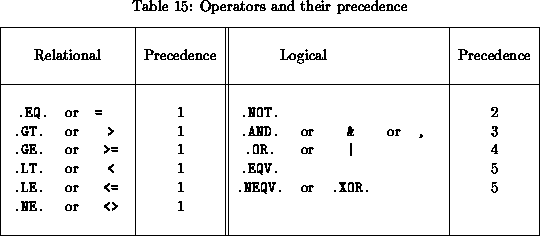




Previous: Unambiguous abbreviations, use of upper and lower case
Up: Syntax rules
Next: Units, values, value-sets and value-ranges
Previous Page: Unambiguous abbreviations, use of upper and lower case
Next Page: Units, values, value-sets and value-ranges

Under several commands logical relations can or must be specified of the form:
keyword.ro.value[,keyword.ro.value[,.....]] , or
keyword.ro.value[.operator.keyword.ro.value[......]]
Here .ro. stands for a relational operator, and .operator.
stands for a logical operator. Arithmetic operators are not allowed.
The six relational operators: =, >, >=, <, <= or
<> (not equal), and their FORTRAN-like equivalents, can be used in the
construction. In some cases only = and <> are allowed,
e.g. when there are only two or three values to choose from. Values specified
with the operators = and <> can be single values, or may be a set
of multiple values or a range of values (see section  ). A wildcard
(
). A wildcard
( ), indicating `any' or `all', is allowed as a value with =
and <> (see section
), indicating `any' or `all', is allowed as a value with =
and <> (see section  ).
).
Logical operators: .AND., .OR., .EQV., .NEQV. (.XOR)
and .NOT., where .AND. may be replaced by ` &' and .OR.
by ` |', can be used to combine keyword constructions
into logical expressions. Table  lists the allowed operators and
their order of evaluation in an expression. Parentheses can be used to alter
the order of precedence. A comma in front of a keyword in the string
stands for a (logical) AND and may be replaced by .AND..
lists the allowed operators and
their order of evaluation in an expression. Parentheses can be used to alter
the order of precedence. A comma in front of a keyword in the string
stands for a (logical) AND and may be replaced by .AND..










 ), indicating `any' or `all', is allowed as a value with =
and <> (see section
), indicating `any' or `all', is allowed as a value with =
and <> (see section 